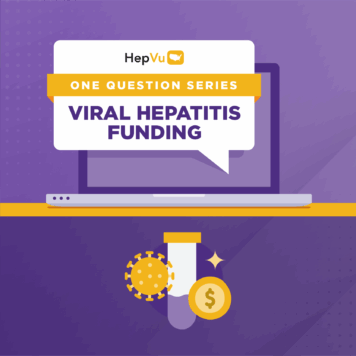Frank Hood is the Manager, Hepatitis Advocacy, for The AIDS Institute.
Q: What brought you to Hepatitis C advocacy and can you describe your work at the AIDS Institute? How do viral hepatitis efforts fit in with AIDS Institute’s advocacy on HIV?
I’ve been fortunate enough to spend my career helping people access better healthcare, safer workplaces, and stronger communities. I started working in the implementation of the Affordable Care Act (ACA), which solidified my focus on public health and how it affects not only individuals, but also entire communities. As I advanced through my career and the opportunity with AIDS Institute around Hepatitis C came up, I realized that we were just resources and dedicated personnel hours away from eliminating this infectious disease – and jumped right in.
Working in the progressive and LGBTQ community gave me experience with the impact of HIV, so working with an issue directly tied to HIV is another big reason I moved into the viral hepatitis space. We can’t talk about HIV health unless we also talk about viral hepatitis health. About a third of people living with HIV in the U.S. are also co-infected with viral hepatitis, either Hepatitis C or B. Persons with HIV and viral hepatitis have worse health outcomes than those persons who have viral hepatitis but are not infected with HIV.
At The AIDS Institute, we advocate a syndemic approach to viral hepatitis elimination by leveraging not only best practices, but also the existing public health infrastructure for HIV, STDs, and other infectious diseases. For example, if someone gets an HIV test, they should get tested for viral hepatitis at the same time.
In addition to screening, there are connections within HIV treatment programs, such as the Ryan White HIV/AIDS program, to provide viral hepatitis care for co-infected patients. Viral hepatitis advocates also keep updated on the U.S. Department of Health and Human Services (HHS)’ Ending the HIV Epidemic: A Plan for America (EHE) plan, because it provides an infrastructure framework that can also positively impact viral hepatitis in the country by expanding provider locations and scope of programs to attract people living with viral hepatitis. The AIDS Institute and various viral hepatitis organizations will participate in advocacy days with other infectious disease groups to work together because these diseases are very much intertwined. There is a huge syndemic focus on these diseases, including injection drug use and lack of sterile injection equipment.
Q: What is the current landscape of viral hepatitis funding in the U.S.? How does it compare to other diseases, and has it been impacted by the COVID-19 pandemic?
The current funding landscape for viral hepatitis in the U.S. is abysmal – but improving. We have had some success generating additional funding from Congress over the last four or five fiscal years, but it is still dramatically less than what we need.
The impact of COVID-19 on viral hepatitis funding is complex. State and local budgets have taken a hit in the last year, and we are concerned that there may be budget cuts that could set back viral hepatitis programs as a result. Many of those programs had to reduce their activities in 2020 because of COVID, and we expect to see an increase in unmet needs in 2021. Congress did not allocate any hepatitis-specific funding as part of the COVID stimulus packages in 2020, but we will be advocating for that this year. That said, COVID-19 has also really put a spotlight on the value of a strong public health system, and what happens when that system is neglected. We hope that will spur some members of Congress to champion increasing funding to fight infectious diseases, including viral hepatitis.
Q: How does the federal appropriations process impact viral hepatitis funding and our collective work towards elimination?
Every year, Congress has to enact a budget to fund the activities of the federal government. The appropriations process is how it decides which programs are funded, and at what level. Some programs, like Medicare, Medicaid, and Social Security are mandatory, but almost all others, such as those that fund viral hepatitis programs, receive annual funding that must be appropriated each year. For the past decade, there has been a cap on all of those annually funded programs (called “discretionary” programs) that has limited how much funding is available for all of them.
The federal appropriations process can truly be a magic bean. If it was the political will of Congress and the administration to say, “Yes, we are going to fund viral hepatitis elimination in the states,” it would have a massive impact. As I mentioned earlier, the only barriers between us and elimination are resources and dedicated personnel hours. So much of the appropriations work we do is educating members of Congress about how viral hepatitis affects their constituents and try to enlist as many as we can to make viral hepatitis elimination a top funding priority.
Even though there are more advocates, more patients being treated, more medications, and more information – there still are not enough resources and personnel. A strong federal response is truly needed to combat a nationwide problem like viral hepatitis. States just don’t have the resources to address it one by one, or the ability to change programs such as Medicare, the Department of Veterans Affairs, Ryan White, federal Medicaid or corrections policies, which are all key parts of the solution. So we need to keep working for a strong federal response to achieve our collective work towards elimination.
Q: Funding is an essential element of creating and maintaining viral hepatitis surveillance systems in the U.S., but current levels of funding have been inadequate to conduct the robust surveillance needed. Given the new administration and new Congress, how can viral hepatitis stakeholders advocate for resources necessary to address the hepatitis epidemic?
This is one area where COVID-19 has helped advocates make the case to members of Congress. Prior to the COVID-19 pandemic, many members of Congress and their staff did not really understand the importance of epidemiology and surveillance data in responding to an infectious disease outbreak. But because of COVID-19, they now have a far better understanding of the importance of these elements in infectious diseases.
Since COVID-19, we can walk into an office and say, “Hey, remember how states couldn’t figure out where their COVID-19 cases were? Apply that times X-number to all the states. That’s what we’ve experienced with viral hepatitis and why we’re asking for funding.” We’re now able to point to a timely and relevant example of why surveillance in infectious disease is important instead of having these conversations theoretically.
And because members of Congress are holding virtual meetings due to COVID-19, more advocates can be involved without having to visit Washington D.C. in person. If you work at a viral hepatitis or a harm reduction program or if you are a person with lived viral hepatitis experience to share, there are opportunities to work with advocates in DC to participate in education meetings we will be having over the next few months. You can also use these links to call or email your representative or senator. Elected officials and their staff do not hear enough from their constituents on these issues, and those personal stories are the most valuable advocacy tools we have. If you would like to get involved in viral hepatitis advocacy, don’t hesitate to reach out to me at fhood@taimail.org for more information about how to get involved.
Q: Sound surveillance information is critical to inform viral hepatitis elimination efforts, but it’s not the only funding priority. In terms of program and research, what are the other key funding priorities that Congress should consider?
Surveillance is incredibly important – but we can’t have surveillance unless we have testing. Not only do we have a broken surveillance system, but we also have an inadequate testing system. Somewhere between a third to a half of people living with hepatitis aren’t aware of their status because they’re often asymptomatic, similar to COVID-19. Again, this is a great example of another infectious disease in public health that is applicable to the viral hepatitis landscape.
After testing, there needs to be an established continuation of care. Knowing your hepatitis status isn’t helpful if you don’t know the next step. Linking the patient to treatment, and in the case of Hepatitis C, a cure is important to elimination efforts. Congress oversees and provides funding for so many different programs in the federal budget that are potential touchpoints to increase access to care. For example, Congress’ investment in eliminating Hepatitis C among veterans at the Department of Veterans Affairs showed that dedicated funding in federal health care systems for Hepatitis C treatment can have outsized success. If Congress prioritizes Hepatitis C treatment in other federal programs like corrections and Ryan White, the nation can continue to move toward viral hepatitis elimination.
Another item I hope will be focused on by Congress and the administration is supporting state elimination work. While elimination efforts require strong federal leadership and funding, the actual planning needs to happen from the ground up. Someone like me sitting in Washington, DC who has never visited the state of South Dakota should not be writing the elimination plan for that state. People living with hepatitis, those in priority populations, medical providers, and other local health officials in that state should be writing the plan. These plans take time, effort, and coordination – all possible only by funding. The federal agencies should signal to the states that they are supportive of state elimination efforts and provide resources so states can start planning if they haven’t done so already.
Q: Recently, HHS and the CDC Division of Viral Hepatitis each released their own national viral hepatitis strategic plans. What role do you think these plans will play in funding discussions for viral hepatitis in the new fiscal year?
The national strategic plans are at the very top of the pile when we walk into a Congressional office. These expert-written plans drive the conversation because they succinctly show the scope of the problem and what needs to be done.
Advocates had a hand in every aspect of the planning and development of the latest HHS plan, and we’re very pleased with its strong goals. As the new administration comes in, we’ve been focusing our transition work on conveying the immense value of the HHS plan and other plans. Even though it was done in one administration, it will need to be championed and implemented by other administrations.
The plans include information on every aspect that really needs to be tackled – it doesn’t go into enough detail, but that’s why we need state planning as well. The national plans lay out strong frameworks of actionable items that the federal government and Congress can act upon immediately and create real impact in the viral hepatitis landscape in the U.S.




